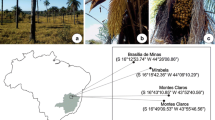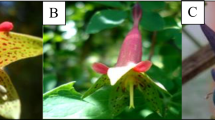Abstract
Thermologic investigations were carried out on three species of Amorphophallus: A. konjac, A. paeoniifolius and A. titanum, all the three strongly thermogenic. Moreover, their breeding system is described as protogynous, the heat production occurs in the appendix and male florets, no warming is seen in the female florets and pollen is shed after the end of heat dissipation. All the three have large, impressive inflorescences developed from big corms and have considerable sizes. During their inflorescence, they have a strong scent like rotting meat with carrion smell. Amorphophallus konjac (K. Koch) has a large, exposed appendix that produces a disgusting scent during the day of the female phase of blooming. The appendix produces about 3 W for several hours, and the temperature elevation is about 2.9 K. The low temperature elevation is attributed to a high surface area and a high evaporative heat loss from the appendix. During the male phase of blooming, a second episode of thermogenesis occurs during the same time of day, apparently from the male florets, reaching a maximum of 1.6 W. Amorphophallus paeoniifolius (Dennst.) Nicolson has a spadix that varies considerably from that of A. konjac and A. titanum with an amorphous upper end of the appendix like a shrunken red pepper instead of cone-like appendices for the two others. It shows thermogenic temperature increases of up to +9.1 K in the male florets and +2.6 K for a short time in the appendix. Amorphophallus titanum (Becc.) Becc. ex Arcang is the largest inflorescence of the world, growing up to 300 cm high and 250 cm across. A much smaller plant was observed during its thermogenic period by means of infrared (IR) thermography, IR thermometry, and thermometric data logger. The temperature maximum showed 36.6 °C at ambient 24.0 °C, which means a temperature difference of about +12.6 K. In the morning of the next day, all temperatures are back to ambient at about 24 °C. Estimates of the heat production (about 74 W) were made from the geometric data and special assumptions with respect to the heat transfer.








Similar content being viewed by others
References
Thien LB, Bernhardt P, Deval MSL, Chen ZD, Luo YB, Fan JH, Yuan LC, Williams JH. Pollination biology of basal angiosperms (ANITA grade). Am J Bot. 2009;96:166–82.
Mayo SJ, Bogner J, Boyce PC. The genera of Araceae. Kew, London: R Bot Gard; 1997.
Bown D. Aroids: plants of the Arum family. Portland: Timber Press; 2000.
Beccari O. Untitled note. Bull R Soc Toscana Ortic. 1878;3:271.
Bogner J. Amorphophallus titanum (Becc.) Becc. ex Arcangeli. Aroideana. 1981;4(2):43–53.
Barthlott W, Lobin W, editors. Amorphophallus titanum. Stuttgart: Franz Steiner Verlag; 1998.
Withers PC. Measurement of V(dot)O2, V(dot)CO2, and evaporative water loss with a flow-through mask. J Appl Physiol: Respir, Environ Exerc Physiol. 1977;42:120–3.
Wieser W. Bioenergetik. Energietransformationen bei Organismen. Stuttgart: Georg Thieme; 1986.
Boecker M. Maße und Gewichtswerte. In: Barthlott W, Lobin W, editors. Amorphophallus titanum, Chapter 5.3. Stuttgart: Franz Steiner Verlag; 1998. pp. 27–36.
Seymour RS, Schultze-Motel P. Physiological temperature regulation by flowers of the sacred lotus. Philos Trans R Soc Lond B. 1998;353:935–43.
Seymour RS, Schultze-Motel P. Respiration, temperature regulation and energetics of thermogenic inflorescences of the dragon lily Dracunculus vulgaris (Araceae). Proc R Soc Lond B Biol Sci. 1999;266:1975–83.
Pandley SK. Horticulture, vegetable science, potato and tuber crops. nsdl.niscair.res.in.
Kite GC, Hetterscheid WLA. Inflorescence odours of Amorphophallus and Pseudodracontium (Araceae). Phytochem. 1997;46:71–5.
Kite GC, Hetterscheid WLA, Lewis MJ, Boyce PC, Ollerton J, Cocklin E, Diaz A, Simmonds MSJ. Inflorescence odours and pollinators of Arum and Amorphophallus (Araceae). In: Owens SJ, Rudall PJ editors. Reproductive biology. Kew: Royal Botanic Gardens; 2008. pp. 295–315.
Beath DDN. Pollination of Amorphophallus johnsonii (Araceae) by carrion beetles (Phaeochrous amplus) in a Ghanaian rain forest. J Trop Ecol. 1996;12(3):409–18.
Skubatz H, Nelson TA, Dong AM, Meeuse BJD, Bendich AJ. Infrared thermography of Arum lily inflorescences. Planta. 1990;182:432–6.
Seymour RS, Gibernau M, Pirintsos SA. Thermogenesis of three species of Arum from Crete. Plant Cell Environ. 2009;32:1467–76.
Ittenbach S, Lobin W. Die Titanwurz: (Amorphophallus titanum). Bot Gart Univ Bonn, Inf No. 2, Bot Gart Bonn; 2000.
Gandiwijaja D, Idris S, Nasution R, Nyman LP, Arditti J. Amorphophallus titanum Becc.: a historical review and some recent observations. Ann Bot. 1983;51:269–78.
Lamprecht I, Schmolz E, Blanco L, Romero CM. Energy metabolism of the thermogenic tropical water lily, Victoria cruziana. Thermochim Acta. 2002;394:191–204.
Korotkova N, Barthlott W. On the thermogenesis of the Titan arum (Amorphophallus titanum). Plant Signal Behav. 2009;4:1–3.
Barthlott W, Szarzynski J, Vlek P, Lobin W, Korotkova N. A torch in the rain forest: thermogenesis of the Titan arum (Amorphophallus titanum). Plant Biol. 2008;1–7, ISSN 1435-8603.
Borg-Karlson A-K, Englund FO, Unelius CR. Dimethyl oligosulphides, major volatiles released from Sauromatum guttatum and Phallus impudicus. Phytochem. 1994;35:321–3.
Bermadinger-Stabentheiner E, Stabentheiner A. Dynamics of thermogenesis and structure of epidermal tissues in inflorescence of Arum maculatum. New Phytol. 1995;131(1):41–50.
Nobel PS. Introduction to biophysical plant physiology. San Francisco: W.H. Freeman and Co; 1974. 488 pp.
Jones HG. Application of thermal imaging and infrared sensing in plant physiology and ecophysiology. Adv Bot Res, Inc Adv Plant Pathol. 2004;41:107–63.
Baumann H, Knoche M, Noga G. Gaswechsel sowie Verteilung von Kohlendydraten und Mineralstoffen. In: Barthlott W, Lobin W, editors. Amorphophallus titanum. Stuttgart: Franz Steiner Verlag; 1998. pp. 157–166.
Boecker M. Florale Morphologie und Anatomie (Morphology and anatomy). In: Barthlott W, Lobin W, editors. Amorphophallus titanum, Chapter 6. Stuttgart: Franz Steiner Verlag; 1998. pp. 37–67.
Acknowledgements
We are grateful to the Director of the Botanical Garden of Berlin, Prof. T. Borsch, for the permission to investigate the blooming of A. titanum, and for the technical assistance to Dr. C. Löhne and G. Hohlstein as well as to several gardeners; to Dr. R. Hölzel (Fraunhofer Institute for Biomedical Engineering IBMT, Potsdam, Germany) for lending the IR camera and giving us technical support; and to F. Müller (Institute for Applied Zoology/Animal Ecology, Free University of Berlin, Berlin, Germany) for determining the odour spectra. This project was supported by the Australian Research Council, and the Alexander von Humboldt Foundation.
Author information
Authors and Affiliations
Corresponding author
Electronic supplementary material
Below is the link to the electronic supplementary material.
Rights and permissions
About this article
Cite this article
Lamprecht, I., Seymour, R.S. Thermologic investigations of three species of Amorphophallus . J Therm Anal Calorim 102, 127–136 (2010). https://doi.org/10.1007/s10973-010-0891-9
Received:
Accepted:
Published:
Issue Date:
DOI: https://doi.org/10.1007/s10973-010-0891-9




